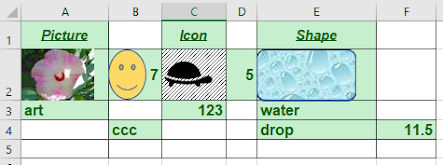If you need to design a colorful title or banner or something similar, so that every character or group of characters or digits has a distinct color, then you can find this post helpful. Here are just two simple examples of effects you can achieve:
You can easily produce such effects quickly by entering your text (including also digits) in any cell of your worksheet, selecting the cell, and running the macro listed below. Just remember that if your cell contains just a number it must be formatted as text for this purpose.
The macro can be entered/copied into any VBA module of your workbook. Obviously, it can be modified as needed for your specific needs. Enjoy!
Sub clrFonts()
'Colors every character within a string of selected cell
Dim cnt As String
Dim rng As Range
Dim n As Long
Set rng = ActiveCell
For n = 1 To Len(rng.Value)
cnt = Mid(rng.Value, n, 1)
If cnt = "a" Then rng.Characters(n, 1).Font.Color = RGB(0, 0, 255): GoTo cont 'blue
If cnt = "b" Then rng.Characters(n, 1).Font.Color = RGB(0, 255, 0): GoTo cont 'green
If cnt = "c" Then rng.Characters(n, 1).Font.Color = RGB(255, 0, 0): GoTo cont 'red
If cnt = "d" Then rng.Characters(n, 1).Font.Color = RGB(0, 0, 255): GoTo cont 'blue
If cnt = "e" Then rng.Characters(n, 1).Font.Color = RGB(153, 51, 0): GoTo cont 'brownish
If cnt = "f" Then rng.Characters(n, 1).Font.Color = RGB(255, 0, 255): GoTo cont 'd red
If cnt = "g" Then rng.Characters(n, 1).Font.Color = RGB(0, 255, 255): GoTo cont 'green blue
If cnt = "h" Then rng.Characters(n, 1).Font.Color = RGB(128, 0, 0): GoTo cont 'brown
If cnt = "i" Then rng.Characters(n, 1).Font.Color = RGB(0, 128, 0): GoTo cont 'vd green
If cnt = "j" Then rng.Characters(n, 1).Font.Color = RGB(0, 0, 128): GoTo cont 'd blue
If cnt = "k" Then rng.Characters(n, 1).Font.Color = RGB(128, 128, 0): GoTo cont 'd grey
If cnt = "l" Then rng.Characters(n, 1).Font.Color = RGB(128, 0, 128): GoTo cont 'vd brown
If cnt = "m" Then rng.Characters(n, 1).Font.Color = RGB(192, 192, 192): GoTo cont 'l grey
If cnt = "n" Then rng.Characters(n, 1).Font.Color = RGB(128, 128, 128): GoTo cont 'l green
If cnt = "o" Then rng.Characters(n, 1).Font.Color = RGB(153, 153, 255): GoTo cont 'l blue
If cnt = "p" Then rng.Characters(n, 1).Font.Color = RGB(153, 51, 102): GoTo cont 'vvd brown
If cnt = "q" Then rng.Characters(n, 1).Font.Color = RGB(255, 255, 204): GoTo cont 'vl yellow
If cnt = "r" Then rng.Characters(n, 1).Font.Color = RGB(51, 153, 102): GoTo cont 'green blue
If cnt = "s" Then rng.Characters(n, 1).Font.Color = RGB(102, 0, 102): GoTo cont 'vvvd brown
If cnt = "t" Then rng.Characters(n, 1).Font.Color = RGB(255, 128, 128): GoTo cont 'd orange
If cnt = "u" Then rng.Characters(n, 1).Font.Color = RGB(0, 102, 204): GoTo cont 'vdd green
If cnt = "v" Then rng.Characters(n, 1).Font.Color = RGB(204, 204, 255): GoTo cont 'dd grey
If cnt = "w" Then rng.Characters(n, 1).Font.Color = RGB(0, 0, 128): GoTo cont 'vvd blue
If cnt = "x" Then rng.Characters(n, 1).Font.Color = RGB(204, 153, 255): GoTo cont 'violet
If cnt = "y" Then rng.Characters(n, 1).Font.Color = RGB(51, 102, 255): GoTo cont 'md blue
If cnt = "z" Then rng.Characters(n, 1).Font.Color = RGB(102, 102, 153): GoTo cont 'greenish
If cnt = "0" Then rng.Characters(n, 1).Font.Color = RGB(0, 0, 0): GoTo cont 'black
If cnt = "1" Then rng.Characters(n, 1).Font.Color = RGB(0, 255, 0): GoTo cont 'green
If cnt = "2" Then rng.Characters(n, 1).Font.Color = RGB(255, 0, 0): GoTo cont 'red
If cnt = "3" Then rng.Characters(n, 1).Font.Color = RGB(0, 0, 255): GoTo cont 'blue
If cnt = "4" Then rng.Characters(n, 1).Font.Color = RGB(0, 255, 255): GoTo cont 'l blue
If cnt = "5" Then rng.Characters(n, 1).Font.Color = RGB(102, 0, 150): GoTo cont '???
If cnt = "6" Then rng.Characters(n, 1).Font.Color = RGB(128, 128, 0): GoTo cont 'greenish
If cnt = "7" Then rng.Characters(n, 1).Font.Color = RGB(128, 0, 128): GoTo cont 'd brown
If cnt = "8" Then rng.Characters(n, 1).Font.Color = RGB(0, 128, 128): GoTo cont 'd green
If cnt = "9" Then rng.Characters(n, 1).Font.Color = RGB(255, 153, 204): GoTo cont 'rouge
If cnt Like "[A-Z]" Then
rng.Characters(n, 1).Font.Color = RGB(255, 0, 255) 'dark red
ElseIf cnt <> " " Then
rng.Characters(n, 1).Font.Color = RGB(0, 0, 0) 'black
End If
cont:
Next n
End Sub






















